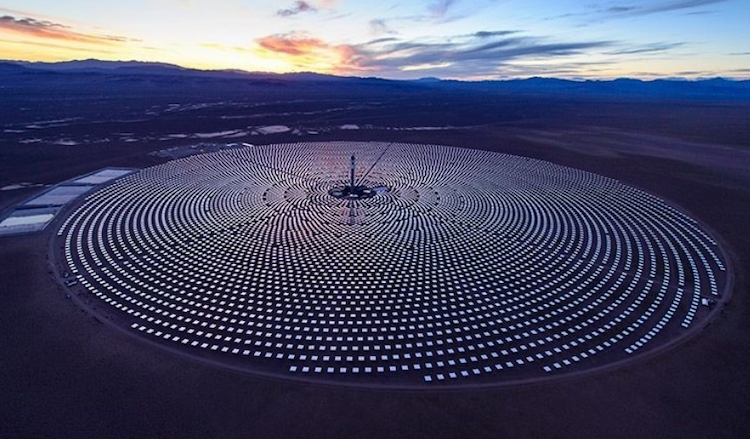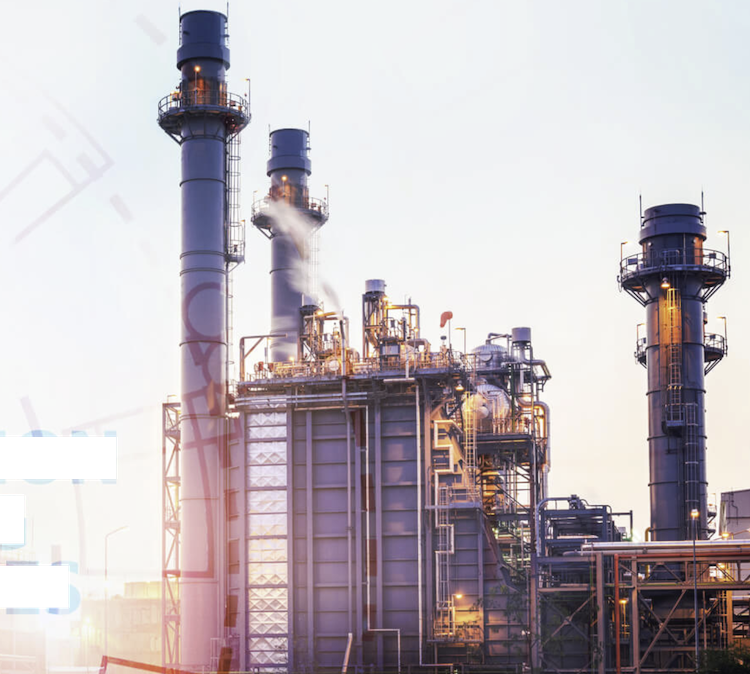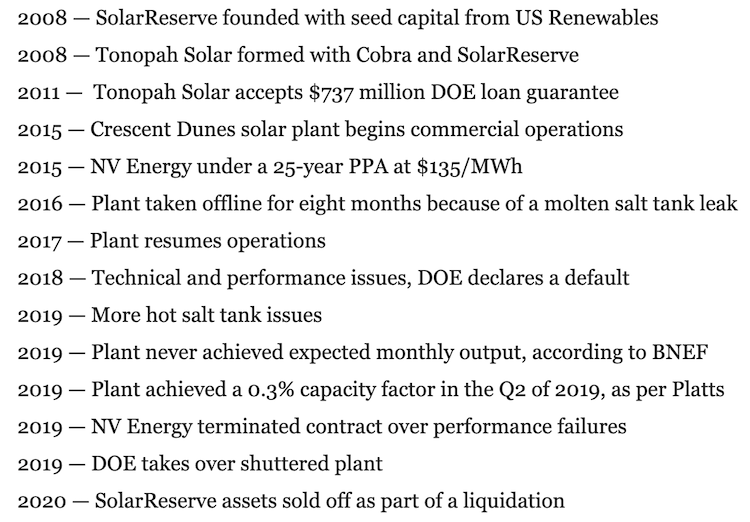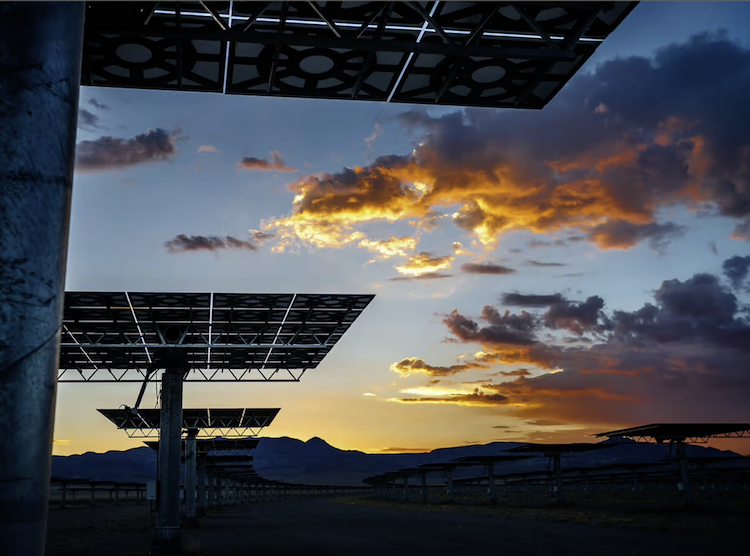
Like the first samples of other new energy technologies, the first full-scale CSP tower with thermal energy storage had a shaky start. Photo ©2015 Jamey Stillings
The Crescent Dunes CSP project in the US was the first of a kind: The first tower CSP with thermal energy storage at full-scale; 110 MW. (Above about 150 MW, the distances of the solar field encircling the tower receiver has optical limits) It was developed by the RocketDyne-based startup SolarReserve, and secured a PPA to supply a new kind of dispatchable solar to NV Energy in Nevada.
Like other trailblazing energy technologies, this first-of-a-kind solar technology had problems. These initially reduced generation and then shut it down in 2020, bankrupting SolarReserve, and ending its pipeline of developed projects in Australia, South Africa and Chile. In mid 2021, it was restarted by the project EPC (Engineering, Procurement, Contracting); Cobra.
This is a transcript of a phone conversation with an engineer who is currently employed on the site in 2023 and has been at Crescent Dunes since SolarReserve began the project, who requested anonymity:
So you were working at Crescent Dunes also back before it closed, right?
Yes. Well, it hasn’t closed. It stopped generating several times. But now it’s back generating again.
So is Cobra running it now?
No, not anymore. ACS is now the new owner. They’re a giant EPC. One of the largest in the world, multinational. They used to own Cobra but they sold them to a French firm, and ACS kept Crescent Dunes. [ED: VINCI acquires energy business of ACS for $5.5bn]

ACS, the new owner of Crescent Dunes is a multinational engineering firm experienced in thermal energy power plants
And who’s actually buying the electricity now? It’s producing energy again according to the EIA.
NV Energy. They came back.
Oh, that’s great. They didn’t give up on it. Do they have a new contract with ACS?
I don’t know. I know that SolarReserve defaulted on the original PPA, but I’m sure NV Energy was dying to get out of that anyway – it was really lucrative, and there were escalator clauses – really good for SolarReserve. That was before PV really drove everything. Now ACS have to compete with PV, because there’s so much everywhere, and it’s cheap during the day, and even sometimes even goes negative – but during the night, they get a much better rate. So that’s the way they are running now – just for nights.
Wow. So now all the daily solar is stored for the night?
Yeah. Now ACS keeps the hot tank full all day. Once they fill the hot tank up, they sell whatever they’re making but keep the hot tank topped off, and then at night, they go full blast. NV Energy needs solar energy at night because they have all they need during the day with PV. But at night, even with the battery backup, the batteries don’t go that far, you know?

EIA data – as of 2023, the project, now owned by ACS, is focused on delivering solar at night only
I heard that the receiver burnt out. Did that get replaced or
No, no, the receiver itself was fine. There was one time when the system was down, and we were testing. This was way back when SolarReserve had it. We were testing defrost, and various things happened, and a hole was burned in a panel. But not the receiver itself.
Did it cause some of the downtime?
No, they fixed that receiver panel in two weeks. Plus, it didn’t lead to any extra downtime because the hot tank was down that whole time.
What did it take to fix that hot tank? What happened exactly?
The first time was just poor design of the bottom. They didn’t design it right. The second time, they had a good design but bad welders. They didn’t have good quality control, or the welders wouldn’t listen. So then it was poor welding on the second one because the welders didn’t do what they were supposed to do. They were welders for petroleum tanks, carbon steel, and they didn’t realize – well they wouldn’t follow the directions of the consultants that Cobra brought in. The sequencing of the welding was critical. They weren’t used to working with these type of alloys that the hot tank required, so that caused the tank to crack again. But now they’ve redone it, and we’ll see.
So the second time then was it Cobra that redesigned the tank to be working better?
Yeah. They bought in some really good people. and they came up with a design that was very close to the original Rocketdyne design. SolarReserve rejected the Rocketdyne design because it was a million dollars more than Cobra or something, a very small amount and then they lost the whole year of production. So it was pennywise and pound foolish. But on the second one, Cobra really brought in good people and made a good design. But then the welders didn’t do a good job. That welding company was – I don’t know where they’re from, but they were more used to petroleum storage tanks. They’re not in the same category. The steel that they use is just a carbon steel for those tanks. So it’s a whole different type of material. So the way that you weld it was very different. It was quite interesting. They had things so, you know, the tank could actually move itself and go back. I think they spent a lot of time and they very thoroughly designed it but then they got hit by the welders not doing what they were supposed to do. That they didn’t listen.


Crescent Dunes began generating at the end of 2015 – and generated at various levels due to technical problems for 4 years before shutting down in 2020. Starting in 2021, under new ownership, it has resumed operation. The two tank leaks caused shutdowns for repairs, and slow reloading with molten salt which takes months, in 2016-2017 and then in 2019
So is it completed?
Yeah, they fixed it again, and now they’ve gone. We are essentially recommissioning it now. We are heating up the tank slowly and also bringing the superheater back.
The superheater?
Yeah. There’s been an issue with one of the superheaters in the power block – these need two superheaters and back when they were SolarReserve and Cobra, one of the superheaters sat with water in it, and it got rusted out. So they’ve had to rebuild this superheater. So they’re running with just one now, at half capacity. I think it’s almost ready and once it’s ready – once this second one is there, they’ll go back to full capacity. They’ve already repaired it, and they’re in the process of re-commissioning it essentially.
What does a superheater do?
Once the salt is produced, the salt heats the water through a heat exchanger. And then it’s part of regular steam plants with a standard Rankin cycle, there’s a reheater, an economizer, and a superheater. They need all three of these to get the efficiency of the thermodynamic cycles. The superheater puts the steam into a super heating state. So it can go through the turbine more efficiently, extracting more energy.
So is a super heater expensive that it’s taken that long?
Yes, it’s a big stainless vessel – an alloy with tons of tubes in it. And it’s made of a very expensive alloy. But the pandemic slowed everything down.
Anyway this is just a basic thermal power plant issue.
Yeah, right. It has nothing to do with the solar side. A superheater is part of every regular steam plant.
Interesting that ACS’s experience is in thermal power plants, but they’re having no problems with the solar aspect.
Yeah. The solar field is, you know, much easier. There’s very little trouble in the solar field, the new technology, compared to the old technology in the power block. But all of that thermal equipment in the power block – the weight of that liquid salt coming into the tank, it goes down from 40 feet up, and that weight is periodically going down and up, and all the valves, the “down comers” – the tubes to the furnace walls – all of these are subjected to very high-temperature swings and vibrations. So the solar field is heliostats, and they move slowly, you know, they’re just little motors, and they’ve been no problem. So all the new tech, it’s all going well. It’s just the old tech that’s having these troubles.

Now owned and run by ACS, Crescent Dunes now delivers solar energy just at night for NV Energy in Nevada
Right. It’s not operating at full scale now, but could it be?
Yeah, as soon as they get the superheaters working and then they can heat the tank back up slowly. You want to get it back to thermal. And then they’re double rechecking and recommissioning the superheater.
Oh, so they’re replacing both superheaters?
No, no, they have two, but one is operational. But when you run with only one, they are not as efficient. They’re more efficient with two. One is not even 50 MW. It’s more like 45. But when they get the second superheater, they’ll go over 100 MW. Well, 110 MW, because they use some of that power to run themselves. So they’re trying to get that second superheater in because they want that income.
Who wants the income, ACS?
Yes, they want this plant to make money for them. They’ve been putting money into it. Closing it down would have been very difficult because decommissioning involves huge costs. SolarReserve got a phony engineering analysis of what it would cost to meet the BLM requirements to put everything back the way it was that said it’s only $7 million. And so they went to get a bond for that much. But once they did an actual analysis, it would take $250 million to take down all the heliostats, all the concrete foundations, etc. So, to shut that plant down, you’re facing a huge cost. So that’s an incentive to try to make something out of it.
I see. So now Cobra’s out of the picture. SolarReserve is out of the picture. I know that there were real issues between them.
Yeah, that was unfortunate. Cobra and SolarReserve was an unfortunate mix. Yeah, they signed Rocketdyne, and it was a good group. But the whole culture clash between the Spanish way of doing things and the American way was just too big.
And now it’s ACS with lots of experience in big thermal power plants working with NV Energy, another giant organization.
Yeah, that’s right. And ACS has a huge amount of inertia. SolarReserve was just too small to sustain all these problems, and they just popped.
Wow, that’s really interesting, and I’ll let you go – I know you’re on the freeway. But getting some on-the-ground information is great – thank you so much.
Oh, you’re welcome. I hope it helped. You know, just let people know that it’s not dead: Crescent Dunes is still alive, and there’s a lot of really wonderful things about it.
Yep. And SolarReserve developed a great pipeline globally like Redstone that others are getting built now.
How Port Augusta Got the World’s Cheapest Solar Thermal Power
Morocco’s Ourazazate Noor III CSP Tower Exceeds Performance Targets
Vast Solar’s fix for tank leaks that stymied the first Tower CSP
CSP experts launch SolStor Energy: long-duration storage for the US














































